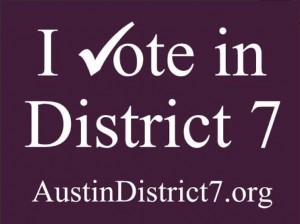by Tom Linehan
Josiah Ingalls kicked off his campaign for the District 7 city council seat on Saturday June 14, warning against the City’s planning strategy for Burnet Rd and similar commercial streets. He also expressed opposition to rail until the City pays down more of its current debt.
Ingalls lives in the Wooten neighborhood. He moved there nine months ago because he and his family were priced out of their neighborhood on Riverside Drive, a result of all of the recent development occurring along the Riverside corridor. He believes the housing affordability problem that Austin is currently experiencing is a result of the City pursuing a path of rapid development. “Austin cannot build fast enough to accommodate everyone moving here,” he said.
City staff will begin land use planning of Burnet Rd and Anderson Ln later this year. Staff intend to separate planning of properties along the corridors from planning of the adjacent neighborhoods. Ingalls said staff took this approach on East Riverside, and the resulting zoning hurt neighborhoods. Developers have been building large developments along the corridor at the expense of existing smaller and more affordable housing options. It increased the number of housing units, but all of them were more expensive than what existed before.
On a related matter, Ingalls believes the City acted too quickly on making changes to rules regarding “granny flats.” Last week, the City Council instructed City staff to research changing the regulations to make it easier for people to build granny flats 500 square feet or less. Ingalls supports the idea of granny flats but believes changes to the existing rules should be part of the City’s CodeNext process.
Ingalls also opposed using tax dollars to bring companies to Austin. He believes the money could be better spent on initiatives that would keep it affordable. “Companies that move here,” Ingalls says, “should pay their own way.”
The City should not move forward with a large metro rail project at this time, Ingalls said. It cannot afford it. Instead, he says, we should be paying down on what we have and devote our efforts to making our existing transportation options work, like connecting buses to rail stops.
Ingalls stressed that he has no agenda to pursue other than to serve the interests of the district. Ingalls, who ran for Mayor in 2009 and then for City Council Place 1 in 2011, said he moved from Seguin to Austin 10 ½ years ago to live in the Capitol where state laws are made because he wanted to get involved and make a difference. He later decided that local government is the best place to start.
Elected officials should understand the cause and effect of the laws they make, Ingalls said. Elected officials take an oath to uphold the law. And what he has seen at City Hall are local laws being made that are contradictory in nature. For example, the city passed an ordinance that prohibits no more than four unrelated people from living in a house. Yet, another city law says that if you live together more than 30 days you are a family. The two contradict one another. Ingalls says it would be better to make laws that make sense, ones that more fully recognize the cause and effect. “Is it a real fix?” Ingalls asks, “or just another band-aid?”
Ingalls sent me an issue paper following his kickoff campaign event which you can read here. IngallsIssuePaper


